The Eye-Opening Truth About The Other 367,000 Babies Who Share The Royal Baby’s Birthday
By Amanda Marcotte
Despite the fact that we formally rejected the monarchy 237 years ago, there was a lot of attention paid in the U.S. to the birth of a new British royal on Monday. While it’s all very exciting that this particular baby was born — and I do wish him well — I can’t help but wonder about the estimated 367,000 babies born (roughly 4.3 born a second) around the world on the same day the most importantest baby ever came to be. While many of those commoner babies were also born into a world of relative privilege and safety — though not royal family levels of privilege, by any means — many of them were not. Many of the babies born Monday are inheriting a world that is dangerous and even deadly, often for reasons that could easily be prevented.
royal on Monday. While it’s all very exciting that this particular baby was born — and I do wish him well — I can’t help but wonder about the estimated 367,000 babies born (roughly 4.3 born a second) around the world on the same day the most importantest baby ever came to be. While many of those commoner babies were also born into a world of relative privilege and safety — though not royal family levels of privilege, by any means — many of them were not. Many of the babies born Monday are inheriting a world that is dangerous and even deadly, often for reasons that could easily be prevented.
Of the non-royal 367,000 babies born Monday, UNICEF estimates that 24,000 will probably not live to see their fifth birthday. Most of the 24,000 children under five we lose a day around the world die from preventable causes: diarrhea, malaria, neonatal infection, pneumonia, preterm delivery, or lack of oxygen at birth. In fact, diarrhea accounts for 16 percent of deaths of children younger than five, around 760,000 a year. Most of these children would survive if their families had access to clean drinking water. Pneumonia, which kills an estimated 1.2 million children under five a year, could be severely reduced with better sanitation, better access to vaccines, and better access to antibiotics, which only 30 percent of children who have pneumonia around the world have access to. (It’s not all bad news! International efforts to implement basic prevention of child death have already reduced the number of small children that die every day by 10,000 since 1990.)
The royal baby can expect to have access to the best education money can buy, of course. The 367,000 babies that share his birthday are facing a much more mixed bag. According to UNICEF, most of them will probably get to go to primary school, but things get a little iffier when we’re talking about secondary school. Right now, fewer than half of children of secondary school age are enrolled in a secondary school. Completing high school does a lot of good things for people, including making it easier for them to successfully read a tabloid magazine article about what the royal babies are wearing these days, so having this available for fewer than half of the royal baby’s birth peers is something we should worry about.
Royal babies probably subsist on a diet of the finest breast milk (no pressure, Kate) before moving on to well-balanced baby foods, but things are dicier for the other babies that also came into the world on July 22, 2013. UNICEF estimates that one third of children in the developing world, including 195 million children under the age of five, are suffering from malnutrition. Again, there are reasons to hope: Supplemental nutrition programs have dramatically reduced vitamin A deficiencies around the world, and if nations can increase their rates of breast-feeding, that’s expected to make a major dent as well. Still, for the babies who share the young prince’s birthday, many thousands are going to be facing some seriously difficult years of hunger and malnutrition, which might stunt their growth.
While being a buzzkill is its own reward, I bring up these statistics for another reason. A lot of the tabloid obsession with royal and celebrity babies is simply cruising on the understanding that the birth of any baby is a happy, exciting occasion. The rest of the 367,000 babies born Monday may not get on the front pages or have news of their birth tweeted and retweeted, but most of them will be greeted with the same love and excitement that Prince William and Kate Middleton are experiencing right now. With some simple interventions and a little more investment in nutrition and preventive health care, a lot more of those families will continue to be as happy five years out as they are today.

